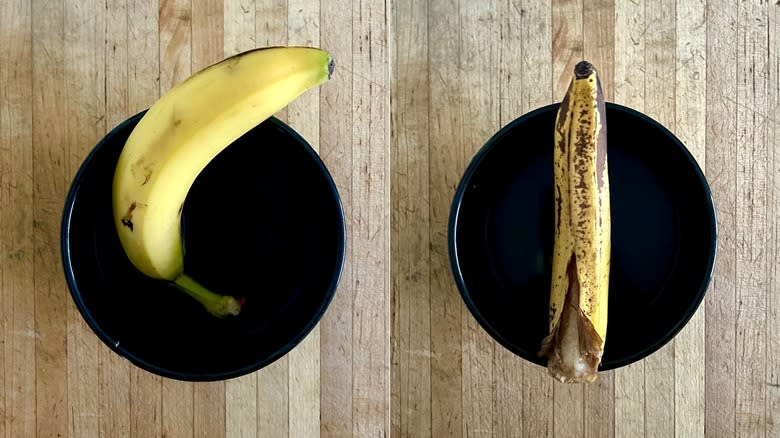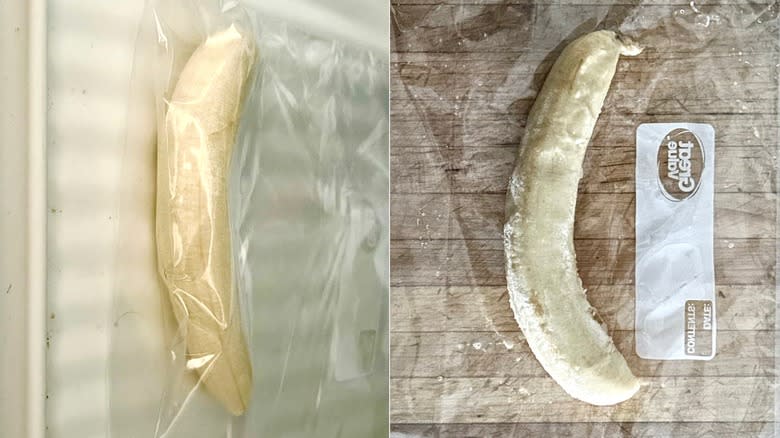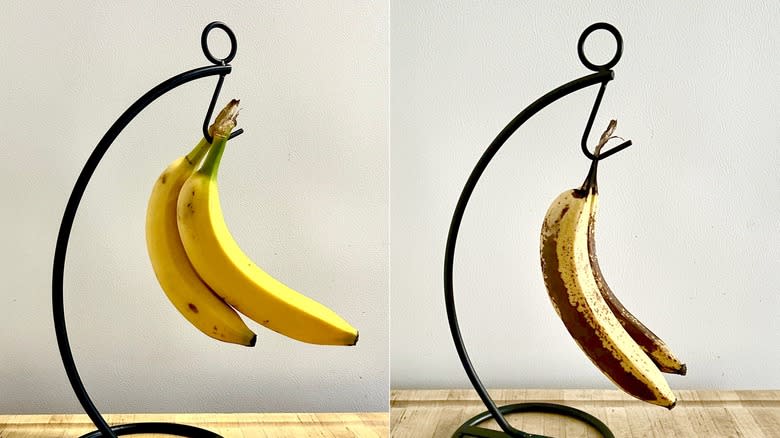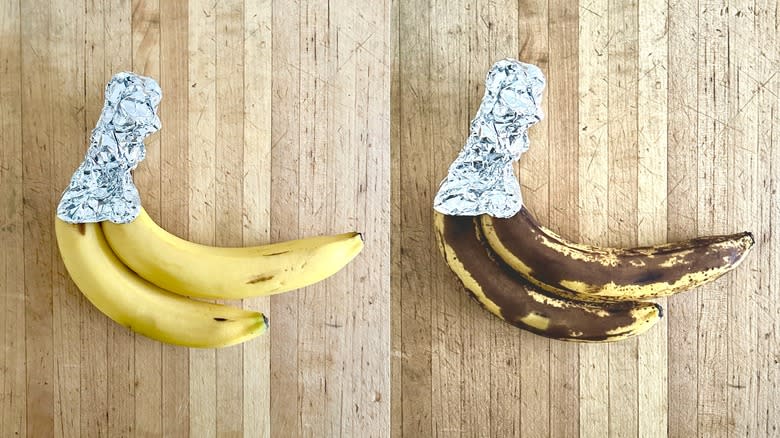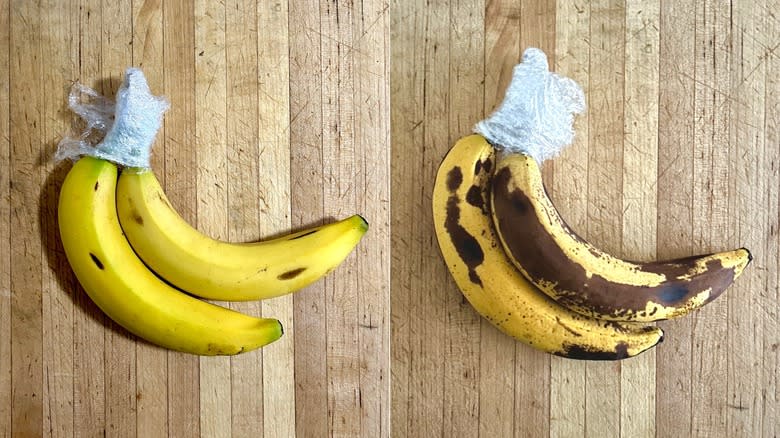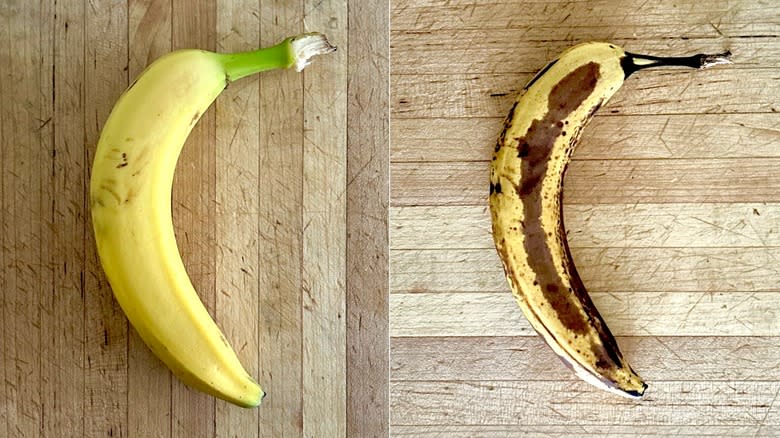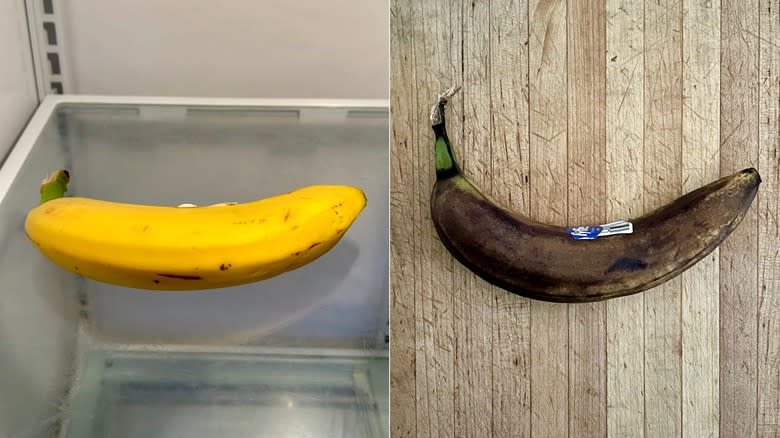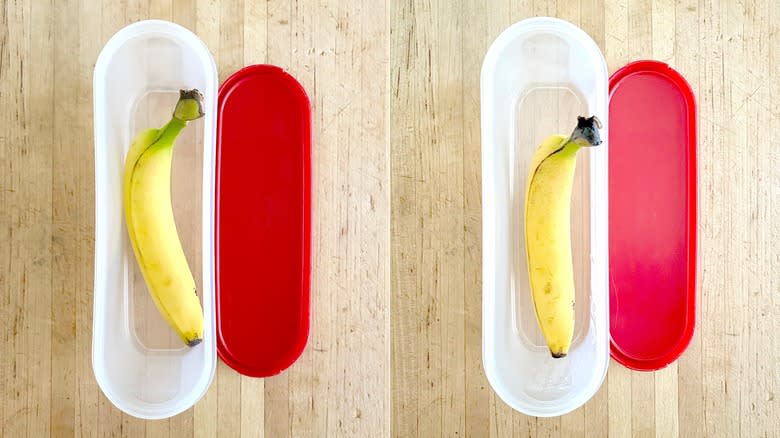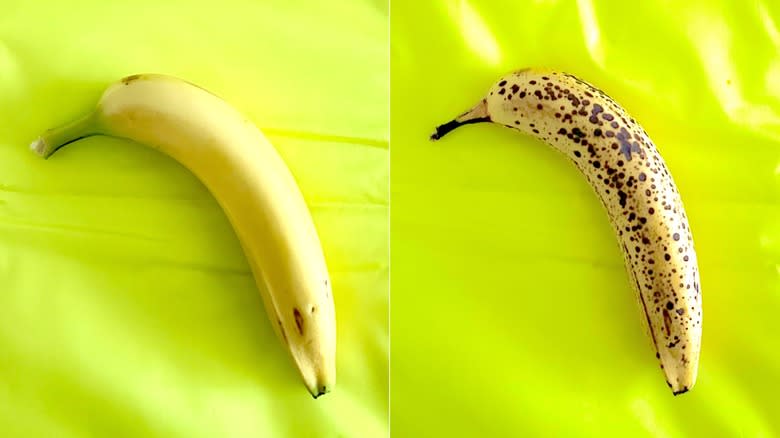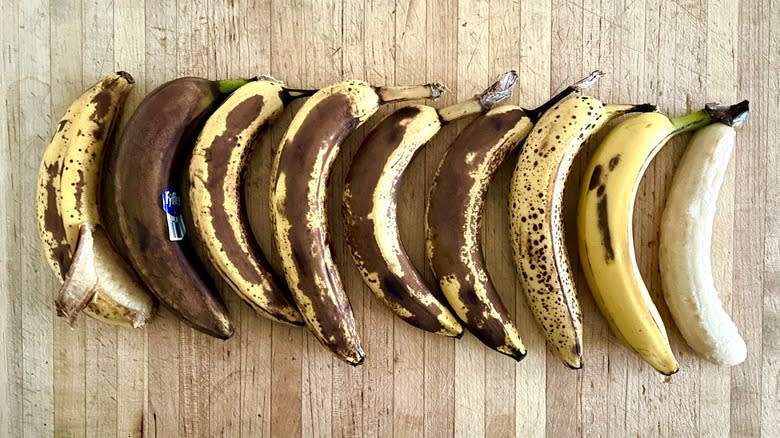Bananas are nutritional powerhouses, loaded with myriad essential vitamins and minerals, including potassium and magnesium, making them popular fruits for many. Unfortunately, bananas are notoriously fickle when it comes to storage. They appear to go from green to ready for the garbage bin overnight. This phenomenon is because bananas are climacteric fruits, or fruits that will continue to ripen after being harvested, and are prolific ethylene gas producers.
While there are basic rules to follow when storing bananas, including removing them from plastic bags, keeping them away from other fruits, and housing them in a cool place away from sunlight, these never seem particularly effective at doing so. I wanted to find out the best method to keep bananas fresh. I scoured the internet for every possible method of preventing bananas from rotting before I could eat them, ranging from some not-so-bizarre theories to some TikTok hacks that seemed rather far-fetched.
As a chef, I had my suspicions as to which of these methods would be the most effective, but to be sure, I tested every one of them simultaneously with the same batch of bananas. You can read more about the methodology I followed for this pseudo-scientific experiment at the end of this article. The results were surprising. Read on to discover which banana preservation method reigned supreme and which was a total disaster.
Read more: 12 Vegetables And Fruits That Used To Look Very Different
9. Store Bananas In Water
When I initially saw this method for storing bananas across social media, I was skeptical but felt it was worth testing. The idea is that the water will prevent airfrom activating the ethylene gas production, slowing the ripening process. This hack purportedly is ideal for warm climates where the heat can promote ripening.
I filled a bowl with cold water and took a single banana, placing its stem end in the liquid until the tip of the fruit was submerged. I then moved the bowl to a cool place away from sunlight and let it do its thing. Within a couple of days, I noticed that the stem end of the banana had begun to split open, exposing the banana to the water. For this to be a fair experiment, I left the banana in the water while the remaining bananas were undergoing their experiments.
The result of this method was a rotten banana. The banana smelled rancid, and the bottom half of the fruit from the stem up had decomposed into a slimy mess. Against my better judgment, I tasted a bite of the other end of the banana to see if it was edible. It was not, and I was concerned that I might end up in the hospital if I ate more of it, so I tossed the banana. This hack gets an F- grade.
8. Store Bananas In The Freezer
This method is not poor for preserving a banana but not ideal for retaining its freshness. Freezing bananas breaks down the cellular structure due to the formation of ice crystals within the fruit. This results in a banana that is no longer toothsome but mushy. While the fruit may not be ideal for eating out of hand or slicing into a bowl of cereal or oatmeal, frozen bananas are fabulous for smoothies and my preferred type for baking as the texture makes them easier to incorporate into the batter.
While there are myriad recommendations for how best to freeze a banana, the key is to peel it before you do so. You can freeze them whole or in pieces by placing them in an airtight container. You can also place banana slices onto a baking sheet lined with wax paper, freeze them, and transfer them to an airtight container. Bananas will remain edible in the freezer for two to three months.
To thaw frozen bananas, pop them in the refrigerator overnight or place them in a bowl and let them sit on the countertop. Do not leave bananas above 40 degrees Fahrenheit for longer than two hours. Alternatively, use the frozen banana pieces instead of ice in your smoothies. As a method for preserving the freshness of a banana, I give this method an F, but that is with the caveat that there is a time and place where this is an effective method of reducing food waste.
7. Store Bananas On A Hook
The method up next on this list is hanging bananas on a hook. There are a couple of reasons this method purportedly works. In theory, doing so hinders the ethylene gas from ripening the fruit by allowing it ample space to escape. Additionally, suspending the fruit will prevent bruising on the surface where the fruit rests on the counter.
There are several options for hanging fruit, from fruit baskets with hooks to under-counter mounted ones to fancy decorative units that you can place on your countertop. I opted to purchase one of the latter as they were the least expensive. I wasn't thinking about how valuable the real estate they occupy in a tiny kitchen would be, making an under counter or ceiling mount far more efficient.
How well did the hook work compared with other techniques for keeping the bananas fresh? Not much better. The bananas continued to ripen, and I noticed the stems started to dry out as they hung there, leaving the fruit tip dry and inedible. The remaining banana was sweet and tender but no less ripe than the ones I left on the counter. I'd give this method a C- grade. It isn't less effective than any other method, but not a miracle hack for freshness.
6. Store Bananas With Stems Wrapped In Aluminum Foil
Wrapping the stems of bananas in aluminum foil is another hack regularly recommended by various sources. The idea behind it is to prevent ethylene gasses from emitting from and ripening the banana. Some sources suggest wrapping the stems together as a bunch, and others suggest separating the bananas and wrapping each one individually. I opted for the former version to reduce waste, keeping in mind the negativeenvironmental impact of aluminum foil.
After allowing the bananas to sit on the countertop for the length of the experiment, I took the foil off the stems and evaluated them. The bananas were perhaps slightly darker than those left on the countertop, but not by a large margin. Their aroma, texture, and flavor were virtually identical to the one on the counter and the ones I had hung. For this reason, I give this method a C grade. It exceeds the hanging bananas in terms of the stem end remaining moist. It does not keep the fruit fresher than simply leaving them on the countertop. I also have concerns about the waste of using that much aluminum foil every time I purchase bananas.
5. Store Bananas With Stems Wrapped In Plastic Wrap
Like wrapping the banana stems in foil, encasing them in plastic wrap is purported to keep the ethylene gasses from escaping and ripening the fruit. This method also has iterations of wrapping the bananas as a bunch versus enveloping individual banana stems in plastic. I opted for the first method again out of concern for the environmental impact of wasting that much plastic wrap, placing the encased bananas on the countertop for the duration of this experiment.
I will note that the bunch of bananas I used for this experiment came from the grocery store with their stems pre-wrapped in plastic. I found this interesting from the perspective of the protocol followed by food distributors concerned with making sure their bananas arrive at their desired destinations safely and without spoiling. Perhaps this gave me false hope that the plastic trick would somehow exceed others in terms of efficacy. It did not.
From a visual, olfactory, textural, and gustatory perspective, these bananas were virtually identical to the one on the countertop, wrapped in aluminum foil and hanging from the hook. I did not see any reason to take the extra time or effort, nor did I see the point in wasting that much plastic wrap when the method was no more or less effective at keeping the bananas fresh. For this reason, I gave this method a C grade.
4. Store Bananas On The Counter
The control bananas stored on the countertop landed in the middle of this ranking of the best methods for keeping these fruits fresh. You should follow some basics to make this method more effective. Bananas require a cool, dry place, away from sunlight, to stay fresh. The ideal storage temperature for bananas is around 54 degrees Fahrenheit.
Once you get your bananas home, remove them from any plastic bags and place them in a bowl, basket, or straight on the counter. It may be best to keep the bananas in a pantry or elsewhere outside the kitchen where the temperature can heat up when cooking or baking. Additionally, never store bananas along with or near other fruits. The ethylene gas within them can promote over-ripening in other fruits and vice versa.
In the context of this experiment, the bananas on the countertop performed as well as those wrapped in plastic or aluminum and the ones that hung from a hook. They were all equally sweet and tender, if not starting to get a bit on the overripe side by the last day. Nature gets a C+ grade for effectiveness in extending the shelf-life of bananas.
3. Store Bananas In The Refrigerator
We should discuss that you can enjoy bananas at various degrees of ripeness depending on your preferences and desired nutrition. Slightly green or yellow bananas tend to be more starchy. As they mature, these starches convert into sugars, making bananas sweeter and less firm. This higher sugar means riper bananas have a higher glycemic index, which, for diabetic individuals or those who need to monitor sugar consumption, may not be recommended. That said, riper bananas are higher in antioxidants and may be easier for those with digestive disorders to tolerate, thanks to resistant starches converting into simple sugars.
This factor is notable because once you refrigerate your bananas, they will cease to ripen. The cold effectively halts ethylene product, keeping your bananas in a kind of homeostasis. So make sure you only put the bananas in the refrigerator when they are at the ripeness you prefer.
It is necessary to know that bananas are highly susceptible to the cold. When stored in the refrigerator, their peel will discolor, turning dark brown, even if the fruit remains firm. In extreme cases, bananas can incur chilling injury, making the fruit acrid, spotty, and inedible. The banana I refrigerated was yellow when it went into the fridge and dark brown when it came out. However, its fruit was as firm and ripe as the day it went in, earning this method a solid A- grade in efficacy.
2. Store Bananas In An Airtight Container
Another random and dubious hack I saw on various social media channels and online forums was the suggestion that putting a banana in an airtight container would preserve its freshness. Its success seemed unlikely as I anticipated the ethylene gasses would get trapped and cause the banana to ripen faster. Yet, some suggested that if the container was small enough and sealed tightly, it may deprive the banana of oxygen and halt the ripening process.
If I were a betting woman, I would have bet all my money against this method working but decided to give it a go anyway. I put a perfectly yellow, ripe banana in an oblong-shaped plastic container that was not much larger than the fruit. After placing the lid on top of the container and sealing it tightly, I set it aside on the counter for the duration of the experiment.
As the days went on, I noticed that the color of the fruit inside the container never changed. By the time I opened the container, the fruit inside was perfectly ripe and frozen in the same state as it was when I put it in. The only slight hitch in the giddy-up was that the ethylene gasses trapped inside escaped as I opened the container, causing a banana fume-induced high that had me feeling giddy. Aside from the fruit being slightly more tender and having a hint of fermented aftertaste, the fruit remained fresh, forcing me to give this method an A.
1. Store Bananas In A Banana Bag
When I first saw these yellow insulated banana bags, I was highly suspicious of their effectiveness. They claim to keep oxygen outside the bag and away from the banana while regulating temperatures. Sealing bananas in a bag seemed likely to do the same as leaving them in a plastic grocery bag or trapping them in a paper bag with an avocado — encouraging ethylene gas production and ripening the fruit.
I ordered one in the interest of science against my better judgment. While some bags state that you should put them into the refrigerator, others do not, or at least they don't specify either way. This one did not, so I put my bananas in, pulled the drawstring shut, and tied it off to keep it sealed, leaving it on the countertop with the other bananas. I did not open the bag once during the length of time I experimented.
When I finally removed the banana from the bag, I was shocked at how well it worked. The banana had brown spots speckled over the peel, but it was not dark. It was also less ripe than the ones on the countertop, those wrapped in plastic or aluminum foil, and the fruit hanging from a hook. It retained a moist, firm texture and sweet flavor and had a marvelous aroma. I was forced to eat crow and confess that the bag worked. I give this method a solid A grade.
Methodology
To determine the methods used for this experiment, I conducted an exhaustive search online, seeking the most commonly recommended ones from reputable food websites and more obscure ones suggested by average Joes on social media and online forums. Once I obtained a banana bag and hook, I purchased a bunch of bananas, dividing them into groups to test each method.
I used bananas that were not green and not beginning to brown in hopes of having a clear visual distinction between the pre- versus post-experiment fruit. I waited seven days before assessing the efficacy of the methods until each of the bananas looked sufficiently different and ripened to make a thorough evaluation. Frankly, I was somewhat surprised that these mutant bananas lasted a week.
For each banana, I observed the color of the skin, the aroma, the texture, and, above all, the flavor, tasting the bananas side by side and in succession. Aside from the one that drowned, no bananas got wasted in this experiment. The remaining bananas were consumed or frozen, destined to become delicious banana bread.
Read the original article on Daily Meal.
